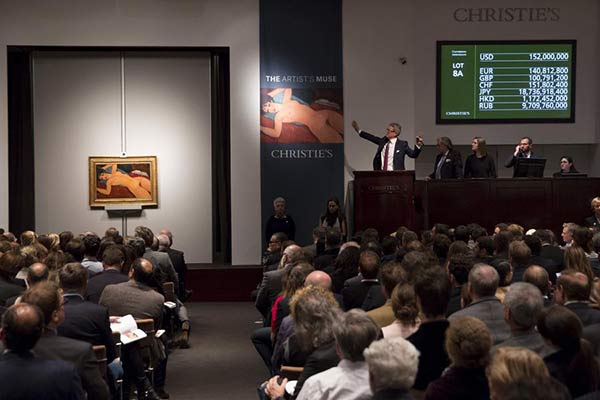 |
|
Christie's auctioneer Jussi Pylkkanen auctions Amedeo Modigliani's Reclining Nude during a curated auction at Christie's entitled "The Artist's Muse" in New York November 9, 2015. [Photo/Agencies] |
Against the unpredictable Chinese economy of the future, and the shrinking of the domestic art market, Chinese wealthy are still splashing big on art. Here are some of the reasons why.
First, wealthy Chinese's pattern of purchasing art overseas may be closely related to their asset allocation strategy worldwide. After the 1990s, the stepping up of globalization has made the global flow of capital and global asset allocation the wealthy's new strategy.
In recent years, many wealthy Chinese are buying real estate, opening or purchasing companies in Europe, USA, Canada, Australia, Singapore and others, while art is only a small portion of their assets.
However, many of these artworks are not taken back to China, and most are preserved in their real estate purchased overseas due to the consideration of spreading wealth to control risk, and the tariff as well. If the artworks enter into China legally, the gross tax will be more than 20% of the purchasing price, which is quite a large expense.
Second, purchasing European art masters' famous works is a status symbol financially and culturally. Millions spent on art will no doubt hit the headlines which causes a stir among media and the public, and the background of these individuals may also get exposed. On the other hand this is great publicity for their companies, including their branding, economic power and social image. Therefore, we can always see that when some wealthy Chinese buys a new art piece, it is announced to the public at once.
Third, the new rich in China buying European and American contemporary pieces also shows their effort in improving their taste in art, and their cultivation. They are trying to keep pace with the taste of global art collectors, usually led by European and American collectors, and are even trying to discover some meaningful pieces which are new creations from fresh artists ahead of them. This may exert a long term effect on the future domestic art market, as the more traditional styles of art may face a crisis, while hybrid Western-Chinese styles and more contemporary art gains a greater market.